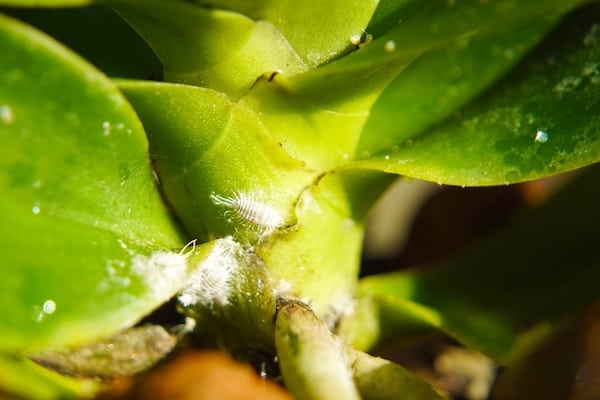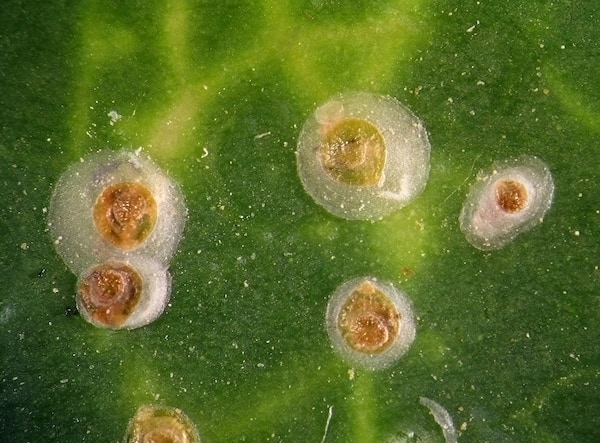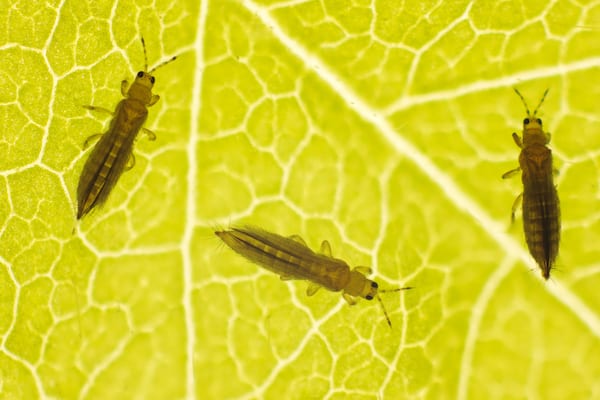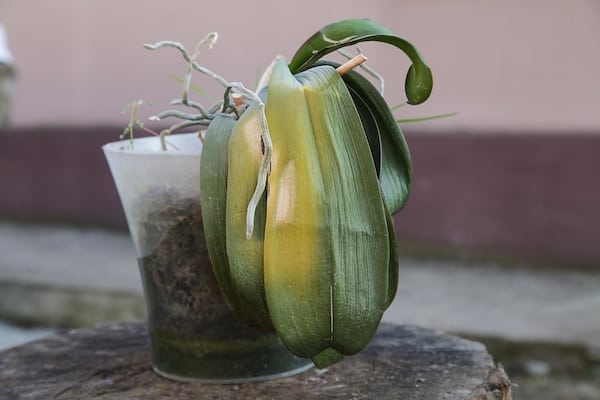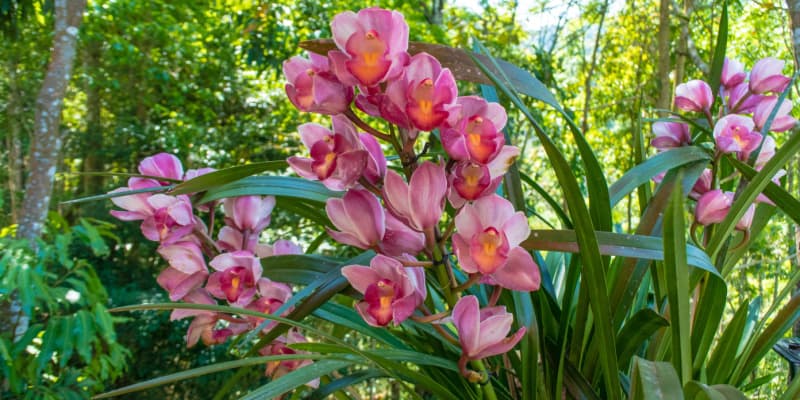
Cymbidium orchid pests and diseases
Our site is reader supported, this means we may earn a small commission from Amazon and other affiliates when you buy through links on our site.
Cymbidium orchid pests and diseases are pretty much the same ones that affect other orchid plants. The pests include mealybugs and red spider mites, and the diseases are mainly fungal ones such as root rot. Here’s how to recognise what’s causing your cymbidium orchid problems and how to deal with the issues.
Pests
Mealy bugs
What are mealy bugs?
Mealy bugs are insects that live by sucking the sap from the leaves of your cymbidium orchid (and every other orchid as well). This weakens the orchid and causes it to become unwell. The plant doesn’t have the strength to create new foliage and may even become too weak to keep up the existing foliage. The leaves can turn yellow.
Search for honeydew
Mealy bugs aren’t that tiny so you can see them. But they do hide away in out of the ways parts of the plant such as the leaf and stem joint. When mealy bugs gather in groups, they’re more easy to find.
But they do leave behind a clear sticky substance called honeydew. This is quite easy to see on the leaves. And ants visibly love this stuff, but that’s mixed blessings.
What to do
Just a few mealy bugs is no big deal. But these few quickly grow into a large swarm that can take over your entire plant. Cut off the infected parts of the plant. And place the orchid plant in isolation as the bugs do spread quickly but they don’t go far.
Insecticides don’t work on mealy bugs so removing them is really the only way to get rid of them. Once they’ve got hold of most of your plant, the only thing left to do is to destroy it.
Soft scale insects
What are soft scale insects?
Cymbidium orchid plants are also prone to soft scale insect infestation. The soft scale insects are around 6mm long with a waxy shell that acts as protection from spray insecticide treatments.
Soft scale insects are also one of the pests that suck the sap from your plant. They feed on stems or leaves, so they go after most of the plant. This weakens the plant and takes away the strength needed for healthy growth. A really heavy infestation can cause the orchid to die back, though this rarely happens. It just continues to look poorly and sad.
Look for honeydew again
These small orchid pests gather mainly on the underside of leaves. Taking a magnifying lens to your plant may help you spot them, especially on the stems.
Conveniently (or not), soft scale insects leave behind honeydew. This is a clear, sticky, sweet substance that you can easily see on your orchid plant’s leaves and stems. Look first on the leaves that are yellow or wilted. This is a substance that doesn’t directly harm your plant. But it attracts ants which may become an issue if you keep your cymbidium outdoors.
What to do
A few soft scale insects won’t harm your plant. Remove them by picking them up with your index finger and thumb when you see them. But keep an eye on your orchid in case their numbers increase.
You can also try spraying them with natural plant oils such as neem or pyrethrum oil. As a last resort, use synthetic pesticide. But be careful if your plant is indoors; look for house plant indoors spray.
Thrips
What are thrips?
You probably won’t ever see a thrip, but they may be on your cymbidium plant. Thrips are pests that are only about 0.1mm long so they’re difficult to find even with a magnifying lens. Look for mites with black or tan bodies with feathery wings.
Thrips are yet another pest that suck the sap from your orchid. In their case, they especially like the buds and flowers from orchid plants. And they also hang around new growth. Thrips are also prone to spread disease so that’s another way they harm orchids.
Look for a silvery colour
Isolate your orchid from all other plants as thrips spread quickly between them. As thrips are difficult to find, look for silvery discolourations on the flowers of the orchid. If your blooms have become shrivelled and drop before opening, that’s a sure sign of thrips.
Open a flower that has thrips and you’ll see them inside. Sterilise your hands and open the other flowers too to check that they’re not infected.
What to do
Try an insecticidal soap that’s safe for orchids – check the instructions on the soap and follow them carefully.
Leave lots of air space around the plant. Air circulation is important to keep the plant healthy.
Continue all these treatments weekly until with the plant is healthy again or the thrips take over fully. If the thrips win the battle, you need to be strong and destroy the plant.
Diseases
Root rot
What is root rot?
Root rot is a fungal disease that many plants get. Both indoors and outdoors plants are susceptible to this, especially if they’re overwatered and left to sit in waterlogged soil. The orchid’s roots become saturated with water and can’t take oxygen in. That limits their ability to send nutrients and water up through the plant.
Look for mushy roots
Root rot starts underneath the soil. You may also notice it in the aerial roots of the orchid. Root rot travels upwards through the stem where it becomes stem rot. You may discover you have a problem when the stem of your orchid turns flexible and soft.
Check the orchid roots and see if they’re brown, black, shrivelled or squishy. This is a sign of this fungal infection. If your soil is very wet, take the plant out of the pot and check the roots closely.
What to do
Sterilise your cutting tool and cut off any roots of the orchid that aren’t healthy. Be careful as you do this as you might have to take away most of the roots. Remove all the existing potting soil and repot the plant in dry soil. I have instructions for how to do this in the article called How to repot a cymbidium orchid.
Review the Water section in How to grow and care for cymbidium orchids to establish a healthy watering regime for your orchid. But the general rule of thumb is to wait until the potting mix is dry in the top 3cm and then to water the plant, making sure that all excess water drains way.
Sooty black mould
What is sooty black mould?
Another fungal disease is black sooty mould. Your orchid may fall prey to this is you have pests that leave the clear, sticky honeydew (see above section). This mould doesn’t directly attack the leaves but it does cover them up with a black powder. This reduces the amount of
Look for black powder
Splotches of black powder on your leaves are a sure sign of black sooty mould. Over time, the black power spreads over all the leaf surface. Without being able to take in sunlight, the plant weakens so that it can’t remain healthy nor produce new growth.
What to do
Sooty black mould is easy to treat. Use a mild solution of soap to wash away the black soot along with the honeydew beneath it. The green leaf appears and can function yet again.
But don’t forget that you still have the problem of what produced the honeydew substance in the first place. Reread the Pests section of this article to try to track down the real problem here.
